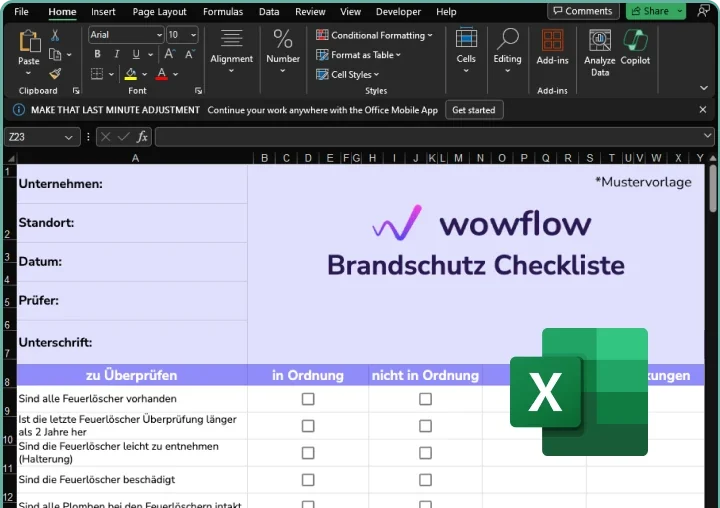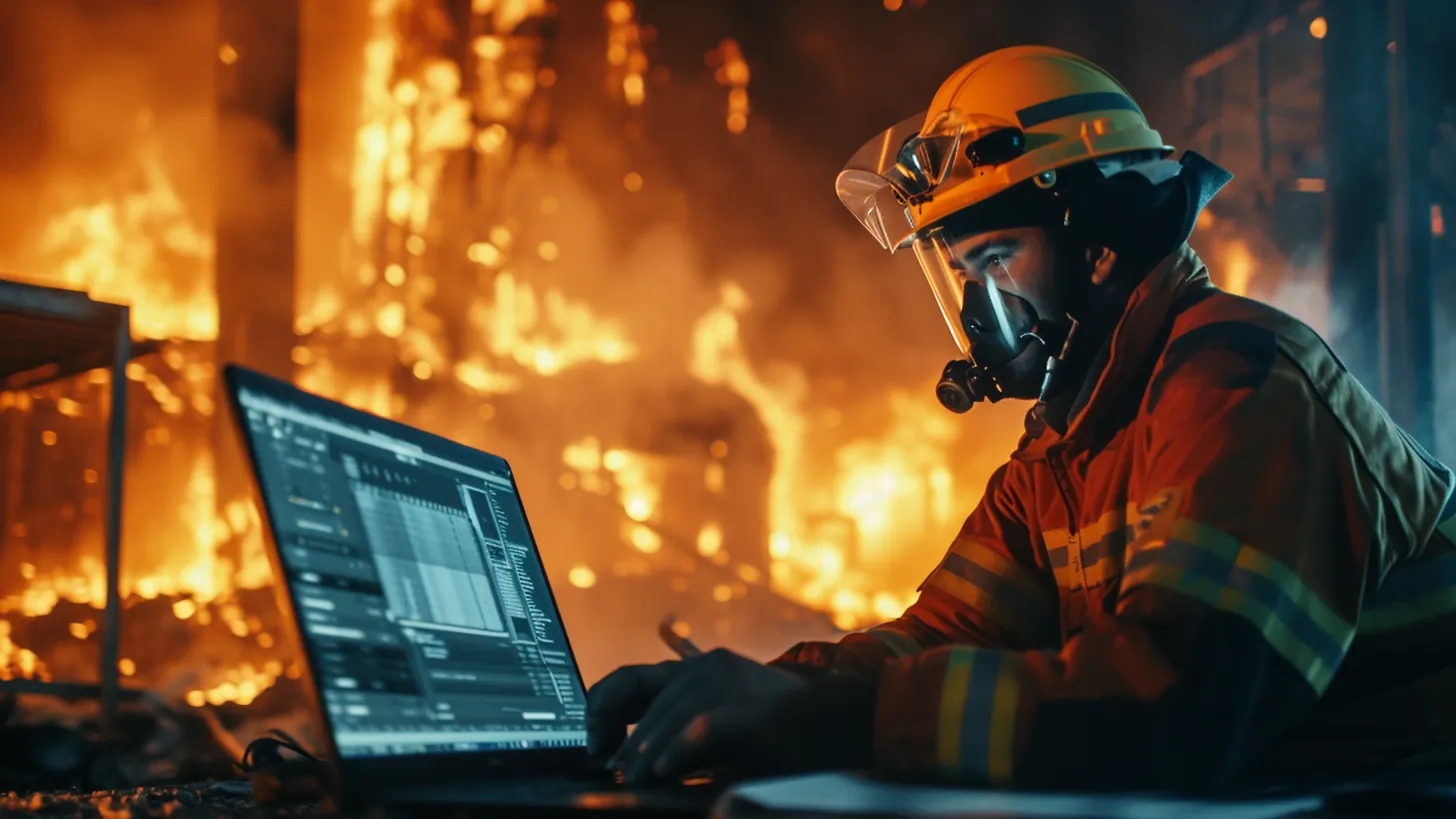Struggling with manual documentation of fire safety measures? It’s easy to lose track of things between the many paper checklists, reports and documental proof, and getting bogged down during a fire inspection.
In our article, you will find out how important it is to have proof of correct fire safety measures. We also write about the functionality of fire safety documentation software, which allows it to be more than simply a tool for easier overview, but also a time saver.
No more stress and guesswork – with the help of our article you can take a more relaxed approach to fire safety documentation .
- Regulations vary from country to country in the DACH region. It is therefore essential to check with your local authorities.
- Fire safety requirements are different for each type of building.
- Dedicated fire safety documentation software has many advantages over Excel, Word, and the paper approach to regular and mandatory fire safety activities.

What is fire safety documentation?
Fire safety documentation is a complete set of rules and measures aimed at protecting both human life and preventing property damage.
Documentation is tedious and time-consuming, but it is required by law.
A building fire can be devastating to people and buildings. Comprehensive and easily accessible documentation is therefore of the utmost importance.
We recommend having both digital and paper variants of fire safety documentation. You will learn more about the advantages of digital documentation below…
Regular maintenance of fire prevention systems plays a key role in facilities management as it helps to minimize fire hazard.
- A practical guide on servicing strategies
- Building management in transition: key strategies for optimizing your real estate
What information does fire safety documentation contain?

What exactly needs to be documented varies depending on the country, region and the local laws. Essentially, all fire safety measures must be documented in a clear and understandable manner, to keep you well-prepared in the event of an inspection.
Despite the different legal regulations, there is common basic information to be included in fire safety documentation:
- Information about the building (plans, floor plan)
- A risk evaluation (fire hazard assessment, fire risk evaluation)
- The fire safety concept (description of the fire safety measures applied)
- Details about fire safety equipment (fire doors, sprinkler systems, fire extinguishers, etc.)
- Fire safety officer information
- Other relevant information (employee training and hazardous materials handling information).

What must be documented in accordance with the regulations on fire safety?
In regard to fire safety measures documentation, it is important to know, that requirements can vary considerably in different countries and federal states within each of them. Individual on site conditions are important to determine the exact design of your fire protection documentation.
To create a set of fire safety requirements, you can refer to DIN 14096 for guidance and to see the different variations.
This standard sets a precise set of rules for people inside a building and defines which information must be visibly displayed inside the building.
A clear understanding of the current legal situation is prerequisite to maintain an overview over fire safety documentation. It is vital to review the legal requirements on a regular basis, in order to ensure that all requirements are met.
In Austria, the labour inspectorate offers an opportunity to ask specific operational questions.
The challenges of managing and updating fire safety documentation in paper form
There are still many cases in which fire safety documentation is kept on paper. This carries the risk that even documents with the best structure could be destroyed in a fire. Even when using conventional programs such as Word and Excel for maintenance management and sending photos by e-mail, is combined with quite a high level of effort.
This allows us to demonstrate the several advantages which come with the use of fire safety documentation software.
The benefits of fire safety documentation management software

The use of specialized software for documentation instead of relying on traditional office applications has its advantages. Such an approach not only enables faster documentation, but also helps to maintain access to information.
This automatically gives you a better overview of the fire safety documentation.
Fire safety documentation with Wowflow – it’s simple, digital and time-saving.
Test now for free to start documenting more efficiently!
Which 7 functions should good fire safety documentation software have?
1. Asset management
Efficient asset management helps to document technical assets within a system. It provides a quick overview and makes it easier to plan maintenance work on time. With Wowflow, you can easily create fire safety device groups, for example for all smoke detectors on the second floor.
2. Checklists
Checklists play a crucial role in regular fire safety inspections, ensuring that no details are overlooked. With Wowflow, you can easily convert the details which have to be checked into a checklist – so there is no chance to overlook important steps ever again.
3. Task management
Clear and transparent distribution of tasks allows everyone in the team to quickly identify who is working on what order and which tasks are overdue. With Wowflow, you can assign tasks to internal employees and external service providers and monitor progress.
Benefit from the uncomplicated integration of our software into your business processes.
4. Activity history
An activity history with a good overview quickly shows which maintenance measures have already been carried out on an asset, who has done it and when.
5. QR codes
By scanning QR codes attached to locations or facilities, anyone with access can easily call up notifications and checklists and obtain other information. This is particularly practical for fire safety inspections.
6. Photo documentation
Nowadays, photographic documentation plays a central role, especially for regular inspections. Photos not only serve as evidence, but also make reporting easier.
7. Text templates
Text templates implemented into our software make it possible to choose on of the repeating text messages with just one click. This makes documentation and reporting much more efficient.
Simplify the documentation of your fire safety measures with Wowflow and save time and worries.
Start now and benefit from efficient recurring tasks functionality.
Tips for selecting and implementing the right software

When choosing and implementing the right software solution, we always recommend considering the Software as a Service (SaaS) option.
This has two advantages: Firstly, you don’t need a large internal IT team because maintenance and updates are handled by the provider. Secondly, your data is not stored locally, which is crucial in an emergency, especially in the case of fire safety.
Using a cloud solution also means additional security. SaaS solutions are characterized by quick implementation, which enables a smooth transition and prompt use of the software.
Rely on a cloud-based SaaS solution like Wowflow for documentation.
Conclusion
Fire safety regulations vary depending on the country and federal state. It is therefore important to obtain information from the local authorities in order to understand the individual requirements for you. The type of building also influences which fire safety measures are obligatory.
Software that focuses on documentation and facilities management offers clear advantages compared to conventional office software. It enables regular updates of fire safety documentation and facilitates maintenance measures for fire safety equipment, such as fire doors and sprinklers.
This makes it easier to comply with all legal obligations. A cloud-based SaaS solution such as Wowflow also offers the additional advantage of not requiring time and resources for updates and maintenance.
Efficient fire safety documentation with Wowflow.
Frequently asked questions
Is fire safety mandatory?
Yes, employers are obliged to provide a safe working environment, and this includes fire safety measures.
What kinds of fire safety measures are there?
There are a variety of fire safety measures that can vary depending on the type of building, its use and local regulations.
Here are some examples: fire extinguishers, fire alarm systems, smoke detectors, escape plans, fire doors, warning signs, sprinkler systems, etc..
What is part of structural fire safety?
Structural fire safety encompasses a wide range of measures and building elements that serve to prevent fires, limit them from spreading and ensure the safety of people and property.
Here are some examples: The building is divided into several sections to prevent a fire from spreading throughout the entire building. The use of fire-resistant building materials for load-bearing elements in a building is intended to reduce the risk of a collapse.
Sprinkler systems are used for direct fire fighting. Fire barriers are designed to prevent the spread of smoke and flames through openings in the walls, for example through cable ducts. Ventilation systems are used to create smoke-free escape routes by extracting the smoke from them.
What are the three pillars of fire safety?
The basis of a comprehensive fire safety concept is formed by three pillars: preventive fire safety, defensive fire safety and organizational fire safety.
Preventive fire safety aims to prevent fires in advance by implementing structural fire safety measures.
A defensive fire safety measure involves fighting an active fire, for example, by using fire extinguishers or sprinkler systems.
Organizational fire safety creates clear structures and processes for evacuation and cooperation with emergency services.
Who is responsible for operational fire safety?
In Austria and Germany, the employer is responsible for ensuring that all fire safety regulations are complied with in the company. If necessary, he can delegate tasks to fire safety officers and facilities managers. However, the overall responsibility lies with the entrepreneur.
What are the fire safety requirements for buildings?
Depending on its use, for example office or residential buildings, and based on its height, floor area and number of storeys, a building is assessed in terms of its hazard potential and classified into one of five different building classes.
The different levels of the building classes require different fire safety measures.
How the building classes are understood is clearly explained in this video:




